Judging from the number of e-gadget users in this country, technology is all the rage. Over 90% of adults have a cell phone. Thirty-four percent (34%) own a tablet. And no one doubts that the percentages will continue to rise. One might also be forgiven for thinking our schools are up to the job of graduating the vast numbers of science, technology, engineering and math students needed to keep this country in the forefront of this technology wave--the interest is obviously there. Unfortunately that is not the case!
By 2018--now less than 4 years and a single generation of high school students away--we are expecting at least 8 million jobs in the US dependent on skills learned in STEM learning courses. But experts estimate that less than five million of those jobs will go to kids from American schools, with three million or more of these well-paid positions going to foreign applicants.
Why is this happening? Why can’t our schools keep up with the demand for young people trained in science, technology, engineering and math? Well as you might expect there are all sorts of excuses for this, from lack of funding to a lack of interest in STEM learning on the part of students themselves. We at RobotsLAB can’t do much about the funding issue; that requires political action. What we can do is help change the culture of math education.
Every year in this country more than a million eighth graders enter high school excited about becoming scientists, technicians and engineers. They have conquered arithmetic in the lower grades and they hope to do the same now in math. That does not happen. By the time they are ready to graduate over 60% of these eager young learners have left the STEM field because they have come to believe that math is difficult, boring and unrelated to their lives. They realize that without a solid understanding of math, any chance of a career in science, technology and engineering is closed to them.
Math may be the last subject represented by a letter in STEM, but it is easily the most important subject overall. The "S" (science), the "T" (technology) and the "E" (engineering), the STE wouldn’t even exist in the absence of math. But in spite of its importance, math is still taught in a manner that puts more kids off STEM than on!

RobotsLAB’s team of roboticists, engineers, teachers and professors are dedicated to fixing the education system using 21st century technology, bringing math to life and preparing students for their future. Our first product, the RobotsLAB BOX has been well received by educators. The BOX and its attendant robots now give committed math teachers the chance to demonstrate to students what they have spent their careers desperately trying to show, that math is neither boring, difficult nor unrelated to their young lives. More, learning math with the right tools is enjoyable.
Simply selling cell phones and tablets developed and made somewhere else is not enough to insure this country’s economic and scientific primacy. Simply importing qualified applicants is not enough; our schools need to train more scientists, technicians and engineers for the burgeoning STEM job market in the coming years. How can we make this happen? By using 21st Century math teaching tools, including our interesting, engaging RobotsLAB BOX.


